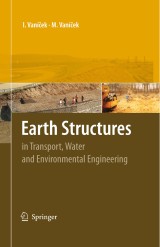Details

Earth Structures
In Transport, Water and Environmental Engineering|
213,99 € |
|
| Verlag: | Springer |
| Format: | |
| Veröffentl.: | 30.05.2008 |
| ISBN/EAN: | 9781402039645 |
| Sprache: | englisch |
| Anzahl Seiten: | 637 |
Dieses eBook enthält ein Wasserzeichen.
Beschreibungen
One of the plausible perceptions about safe and generally optimal geotechnical structure, leads to the conclusion that its success is supported by four columns. The ?rst column relies on the understanding of natural sciences such as Geology, Engineering Geology and Hydrogeology on one side, and on the understanding of Mechanics, Theory of Elasticity on the other side. The second column relies on the application of existing ?ndings on the behaviour of soils and rocks under different stress-strain states – we are speaking about support from Soil Mechanics and Rock Mechanics. The third column relies on the combination of the theoretical ?ndings with practical technologies during execution of Foundation Engineering and Und- ground Structures (Tunnelling). Finally the fourth column relies on a certain feeling of geological environment which Terzaghi (1959) denotes as “capacity for ju- ment” and he speci?es that “this capacity can be gained only by years of contact with ?eld conditions”. Theauthors are con?dent that the third column relevant to practical application should be strengthened about “Earth Structures”, about application on structures, which belong to the oldest engineering structures utilizing the fundamental str- tural material – soil. At the same time they believe that Earth Structures will est- lish their position in the near future, as it is gaining another interesting ?eld which Earth Structures are also part of, namely the ?eld of Environmental Geotechnics.
– Design Specification for Earth Structures.- Soil as a Construction Material.- Geosynthetics in Earth Structures.- Soil Improvement.- Limit States for Earth Structures.- Earth Structures in Transport Engineering.- Earth Structures in Water Engineering.- Earth Structures in Environmental Engineering.
<P>While soil is the oldest, most commonly used building material, there is a paradox in that the subject of Earth Structures has never previously been comprehensively covered. This book describes the principles of working with soil as a construction material, including two basic ways of treating it: geosynthetics and stabilization. The book discusses the design logic and ways to control Earth Structures, which differ significantly from other construction materials. Building with Earth involves greater uncertainty and risk, which means that there is a need for better design detailing and improvement in the quality of financial calculations.<BR>The general part of the book gives a detailed description of the principles of limit states according to Eurocode 7, after which geotechnical design is also described. Subsequent chapters concentrate on earth structures for transport, water, and environmental projects.<BR>The chapter on Earth Structures in transport engineering presents detailedcoverage of limit states of stability and deformation. Earth Structures in water engineering prioritizes the limit state of internal erosion. Earth Structures in environmental engineering describes new designs, in which part of the structure is created from non-standard materials which are usually susceptible to internal collapse, double porosity, unsaturation, etc. It also focuses on protecting the surrounding environment from contamination. <BR>With its emphasis on principles, the logic of processes, and understanding the most important problems, the book allows all those involved with a construction (client, designer, contractor and supervisor) to build such earth structures more safely and economically.</P>
<P><EM>Audience:</EM> <BR>This book will be of interest to civil and environmental engineers; transport, hydraulic and planning engineers; geotechnical and geo-environmental engineers; scientists, designers, contractors, clients and supervisors; postgraduate students. </P>
<P><EM>Audience:</EM> <BR>This book will be of interest to civil and environmental engineers; transport, hydraulic and planning engineers; geotechnical and geo-environmental engineers; scientists, designers, contractors, clients and supervisors; postgraduate students. </P>
First complex elaboration of the problems of all earth structures types Soil as main structural material including its improvement using geosynthetics or stabilization is presented Limit states of earth structures are described in accordance with Eurocode 7 Considers the environmental aspects of waste in earth structures
<P>Soil is the oldest and most used building material, but until the publication of this book the subject of Earth structures was not fully covered. This text describes the principles of soil workability as construction material, including its treatment using geosynthetics and stabilization. The logic of design and control of Earth structures differs significantly from other building materials, resulting in more uncertainty and risk. Following a description of the principals of limit states according to Eurocode 7 - Geotechnical design, the book concentrates on earth structures of transport, water and environmental projects. The book focuses on the principles, logic of processes, and understanding of the most important problems, so that all participants in the construction (client, designer, contractor and supervisor) are able to build these earth structures more safely and economically.</P>

















